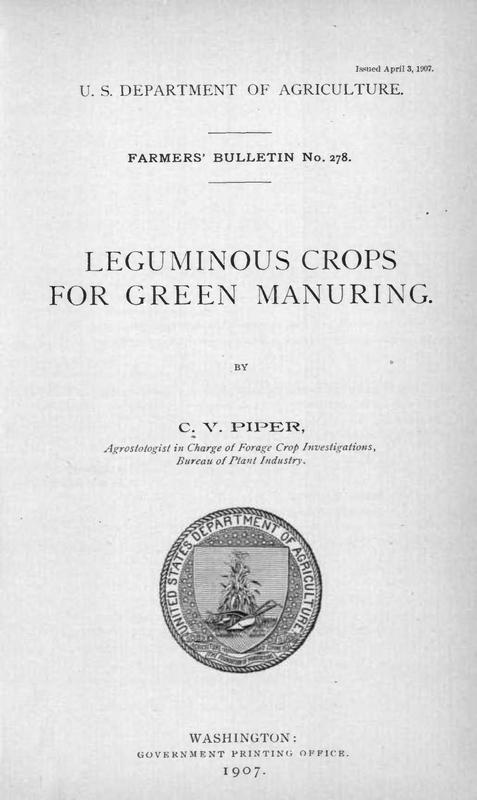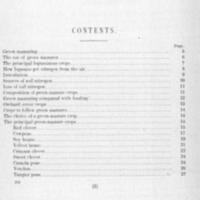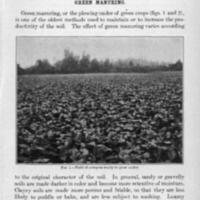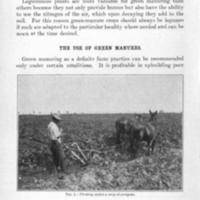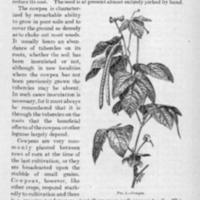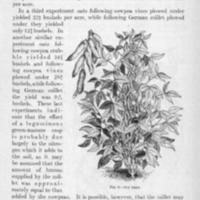Leguminous Crops for Green Manuring
Creator
Date
1907
Excerpt
The cowpea (fig. 5) is used more than any other crop as a soil renovator in the South. Its use is rapidly increasing, but is yet far from general. During the past few years the high price of the seed has tended to discourage more extensive growing. Recent progress in the harvesting of cowpea seed by machinery will doubtless materially reduce its cost. The seed is at present almost entirely picked by hand.
The cowpea is characterized by remarkable ability to grow in poor soils and to cover the ground so densely as to choke out most weeds. It usually bears an abundance of tubercles on its roots, whether the soil has been inoculated or not, although in new localities where the cowpea has not been previously grown the tubercles may be absent. In such cases inoculation is necessary, for it must always be remembered that it is through the tubercles on the roots that the beneficial effects of the cowpea or other legume largely depend.
Cowpeas are very common1y planted between rows of corn at the time of the last cultivation, or they are broadcasted upon the stubble of small grains. Cowpeas, however, like other crops, respond markedly to cultivation and there is a growing tendency to plant them upon well prepared soil. This practice results in a great increase of the crop, whether grown for hay or for seed. (See fig. 1, p. 5.)
More numerous experiments have been conducted in this country to determine the effects of cowpeas used as a green manure than have been devoted to all other leguminous crops combined. Almost without exception these experiments have indicated a very beneficial effect upon the succeeding crop. The benefit often lasts two or three years. These good results follow on practically all succeeding crops, whether cotton, corn, sorghum, or small grains. Except on the poorest soils careful experiments show that it is decidedly more profitable to use the cowpea crop as hay or pasture and then plow under the stubble than it is to plow under the whole crop. While plowing under the whole crop produces as a rule a greater effect, it is not enough greater to equal the value of the cowpea crop as feed.
The cowpea is characterized by remarkable ability to grow in poor soils and to cover the ground so densely as to choke out most weeds. It usually bears an abundance of tubercles on its roots, whether the soil has been inoculated or not, although in new localities where the cowpea has not been previously grown the tubercles may be absent. In such cases inoculation is necessary, for it must always be remembered that it is through the tubercles on the roots that the beneficial effects of the cowpea or other legume largely depend.
Cowpeas are very common1y planted between rows of corn at the time of the last cultivation, or they are broadcasted upon the stubble of small grains. Cowpeas, however, like other crops, respond markedly to cultivation and there is a growing tendency to plant them upon well prepared soil. This practice results in a great increase of the crop, whether grown for hay or for seed. (See fig. 1, p. 5.)
More numerous experiments have been conducted in this country to determine the effects of cowpeas used as a green manure than have been devoted to all other leguminous crops combined. Almost without exception these experiments have indicated a very beneficial effect upon the succeeding crop. The benefit often lasts two or three years. These good results follow on practically all succeeding crops, whether cotton, corn, sorghum, or small grains. Except on the poorest soils careful experiments show that it is decidedly more profitable to use the cowpea crop as hay or pasture and then plow under the stubble than it is to plow under the whole crop. While plowing under the whole crop produces as a rule a greater effect, it is not enough greater to equal the value of the cowpea crop as feed.
Title
Leguminous Crops for Green Manuring
File(s)
Leguminous Crops for Green Manuring cover.jpg
(image/jpeg)
Leguminous Crops for Green Manuring TOC.jpg
(image/jpeg)
Leguminous Crops for Green Manuring 1.jpg
(image/jpeg)
Leguminous Crops for Green Manuring 2.jpg
(image/jpeg)
Leguminous Crops for Green Manuring 3.jpg
(image/jpeg)
Leguminous Crops for Green Manuring 4.jpg
(image/jpeg)
Leguminous Crops for Green Manuring 5.jpg
(image/jpeg)
 An official website of the United States government.
An official website of the United States government.


